This study by Sun et al. 2020 attempts to refute the Younger Dryas Impact Hypothesis (YDIH) by linking the Younger Dryas (YD) onset with volcanism. It was widely circulated in the popular media as posing a significant challenge to the YDIH. The authors used the isotopic ratios of the platinum group element osmium to determine whether it is indicative of normal crustal levels or some sort of event; the ratios between 187Os and 188Os are known to distinctly differ between the two. The authors designate ratios of >1.11 as ‘radiogenic’, or typical of normal crustal ratios, while ratios of <1.11 are designated as ‘unradiogenic’, consistent with extraterrestrial impacts or volcanic eruptions (Sun et al. 2020).
Here are some quotes from their conclusions that attempt to discredit the YDIH:
“The cause of the elevated HSE concentrations and the Os isotopic ratios in YD layer sediments remains equivocal and has been used to both support and negate the YD impact hypothesis. For example, Petaev et al. found a Pt enrichment accompanied with an extremely high Pt/Ir but Al-poor signature in the Greenland Ice Sheet Project 2 ice core at the Bølling-Ållerød/YD transition period, which they interpreted to be consistent with an ET impactor. Also, the elevated Pt abundance anomalies of 100 to 65,000 parts per trillion (ppt) at the onset of the YD in sites from North America is purportedly consistent with the Greenland ice core Pt data. Moore et al. found Pt and Pd/Pt anomalies in the YD basal layer in South Carolina.”
This quote demonstrates that the authors are aware of the widespread reproduction of the Pt anomaly at the YD onset, and that it has been proposed by YDIH proponents as representing a global geochemical datum marking the YDB. It also demonstrates they are aware that the YDB impactor appears to have novel geochemistry.
“The five unradiogenic Os peaks, including the YD layer, fall within a ~4000-year time interval. The unradiogenic 187Os/188Os ratio and HSE abundance data from Hall’s Cave sediments are inconsistent with the YD impact hypothesis. Alternatively, these levels contain cryptotephra and associated aerosols derived from large Plinian volcanic eruptions.”
As demonstrated below, their conclusion that there are five volcanic signatures in their data is unsupportable. Instead, there were three at most, and it is likely that none of them coincides with the YDB; as established above, the Laacher See eruption is completely unrelated to the YDB.
“The YD horizon correlates in time with the Laacher See eruption with a VEI of 6 and a 6.2-km3 eruptive volume that was dispersed throughout the Northern Hemisphere. Previously found YD markers, such as nanodiamonds and other wildfire products, are not necessarily solely impact-induced. Instead, these could originate from high-temperature, large-scale volcanic eruptions whose explosive conditions are capable of producing molten silica and carbon spherules and possibly nanodiamonds (Lonsdaleite).”
The authors cite van Hoesel et al. (2014) to support their claim that lonsdaleite can be formed during a volcanic explosion, and that other YDB impact proxies can have formed by other processes. That paper contains no evidence or explanation of the supposed process, only conjecture. This is just one of many examples of Sun et al. (2020) citing conjecture from other authors, with no supporting evidence, to support their own unfounded claims. As mis-citing literature pales in comparison to the other issues with this paper, I won’t be including a full list here.
“These observations from the Hall’s Cave section also explain the lack of an Os isotope ET signature, or for the interpretation of a cryptotephra signature, at many YD locales across the Northern Hemisphere.”
This is simply not true; the authors ignore several studies that suggest an Os signature in the YDB layer at multiple sites, such as Beets et al. (2008) and Sharma et al. (2009). Prior to studies by Sun et al. (2020, 2021), only Paquay et al. (2009) had failed to locate an osmium signature at the YDB.
“The results here have implications not only for the YD event but also other Pt and Ir enrichment events in Earth history and where other supposed bolide markers have been used to support impacts at those times.”
Despite their flimsy conclusions, Sun et al. (2020) have the audacity to suggest that their results are so conclusive they should enable other previously established impact events in geological history to be challenged, or at least revisited. We are about to see why this is certainly not the case, and instead, this paper should be retracted.
The authors compare the concentrations of osmium in the ‘unradiogenic’ samples to average concentrations in CI-chondrites (486,000 ppt) and continental crust (30 ppt), finding them to be inconsistent with both, which they claim is suggestive of a mantle origin, thus volcanism. However, CI-chondrites are a rare class of carbonaceous stony meteorites and are only tentatively linked to a cometary origin (Anders 1975; Campins & Swindle 1998); it is unclear why only this class of meteorites was chosen for the comparison, and all others were excluded. Different classes of chondrites can have significant variations in rare earth element (REE) concentrations, both within the same class and between classes (Horan et al. 2003; Tagle & Claeys 2005; Riches et al. 2012), and so the exclusive use of CI-chondritic geochemistry is questionable.
To be fair to the authors, most studies usually pick one class of chondrite to compare their geochemistry to, so they should not have been expected to run additional comparisons for other classes. However, if the authors wanted to use their data to discredit another hypothesis, they should have made broader comparisons. Importantly, the authors demonstrate their awareness that the proposed Younger Dryas Boundary impactor has novel geochemistry by discussing Petaev et al. (2013), which first reported the global platinum spike associated with the hypothesised YDB impactor yet decided to only use CI-chondrite values anyway.
Based solely on the unradiogenic osmium ratio and ‘non-chondritic’ REE concentrations in their supposed YDB layer, Sun et al. (2020) claim that the YD was likely triggered by the Laacher See volcanic eruption (LSE). There are a significant number of issues with this claim, addressed in detail by Sweatman (2021a, 2021b), Engels et al. (2022), and Svensson et al. (2021). To summarise, the Laacher See eruption occurred up to 200 years before the YD onset, 13,006 ± 9 yrs ago, based on a high-resolution multi-proxy record that includes radiocarbon and lake varve chronologies. However, the latest-occurring volcanic signature in the GISP-2 ice core, which could be the LSE, occurred at 12,975, while in the same core, the YD onset began 12,855 years ago (Abbott et al. 2021). It is worth noting that radiocarbon dates are not 1:1 comparable to ice core dates, and there is a slight disparity of about ~50 years between them.
According to the interpretation made by Sun et al. (2020), they have identified four additional volcanic events in the ~4000-year sedimentary record on either side of their claimed YDB (Figure 1). The number of events throughout the section is used as evidence in support of this interpretation; if there are five events with strong signatures, they must be volcanic because volcanic events occur much more often than impact events. Even assuming their data is robust, this argument does not make sense. Why can it not have been four volcanic events and one extraterrestrial event with a similar geochemical signature? Either way, it does not matter because this report demonstrates many fatal flaws that should have seen Sun et al. (2020) rejected in peer review.
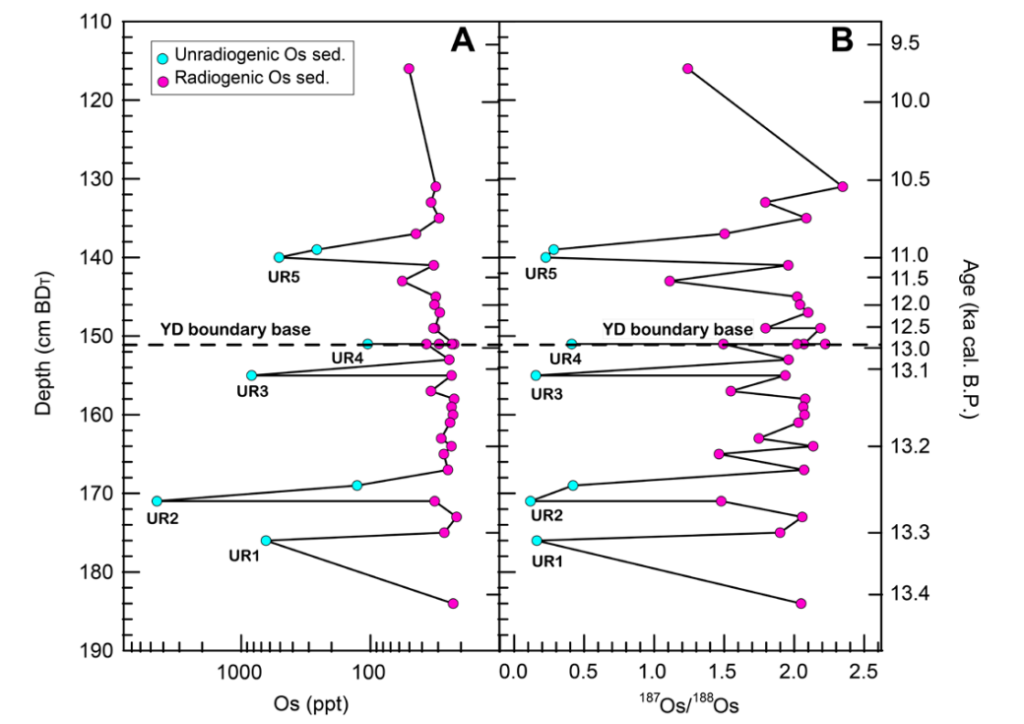
Figure 1. Depth below datum (BDT) profiles against total Os abundances (ppt) and 187Os/188Os ratios of Hall’s Cave sample section. A: Depth versus total Os abundances (ppt). B: Depth versus Os ratios. Local datum used in this study was placed by Toomey, 1986. UR = unradiogenic. UR1 to UR5 represent five unradiogenic Os peaks. Depth values are the basal depth of the 1-cm-thick excavation interval relative to the datum. Six ages were calibrated using direct AMS 14C measurements with 95.4% confidence intervals and then used to calculate the rest of the dates with linear interpolation between the dated levels.
Close inspection of their data (buried deep in their supplemental information) reveals that sediments were sampled during three distinct sampling episodes over three years in different areas of the cave, each using different methodologies: HC15 in 2015, HC16 in 2016, and HC17 in 2017 (Figure 2). This is not inherently an issue in itself, but they made it a massive problem by combining all the data from each sampling episode into a single dataset; this can only work if specific measures are taken to ensure samples from each episode are comparable, which they did not take.
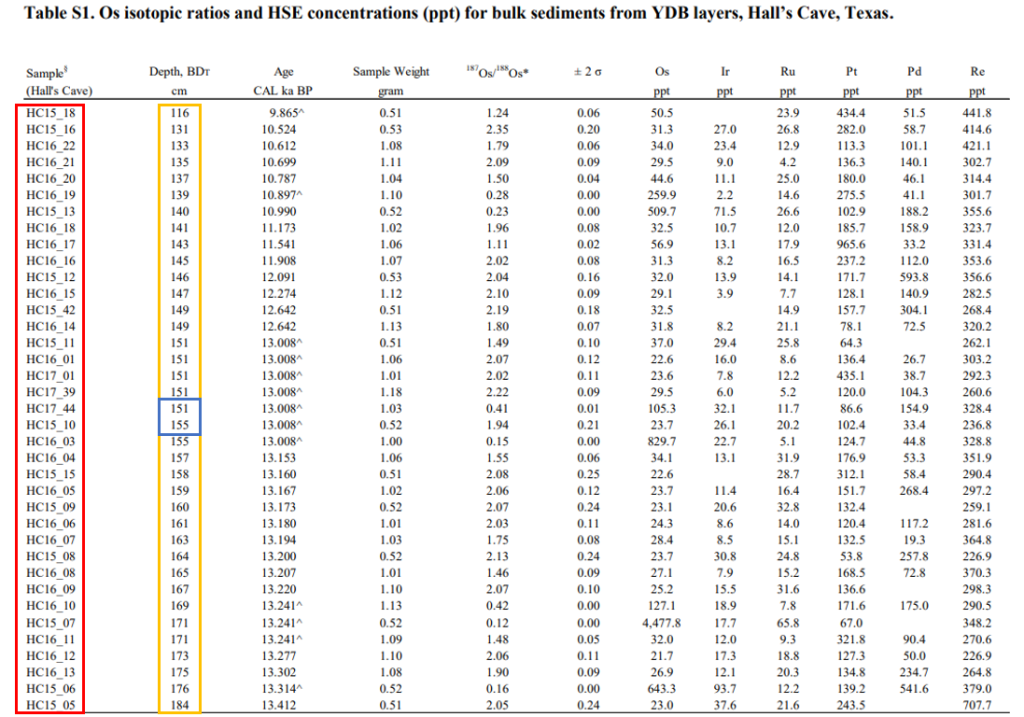
Figure 2. Data table showing sample names, depths, radiocarbon ages, sample weights, osmium ratios, and rare earth element concentrations. Red Box = distinct sampling episodes: HC15 sampled in 2015, HC16 sampled in 2016, and HC17 sampled in 2017. Yellow Box = sampling depths based on site-wide datum. Blue Box = anomalous gap between samples at the YD boundary. Adapted from Sun et al. 2020.
As clearly shown (Figure 2), several depths were sampled multiple times (red & yellow boxes) between each sampling episode, and even within the same episode. For example, samples from 151 cm were sampled in all three episodes, but three times in 2017, for a total of five samples supposedly representing the same layer. However, their PGE abundances and osmium ratios differ significantly between samples taken from within what they claim is the same soil horizon; between the five included samples from 151 cm, their supposed YDB, the Os ratios range from 0.41 to 2.22, and Pt concentrations range from 64.3 ppt to 435.1 ppt (Figure 2).
This means, according to their data, that the osmium ratio and concentration at the 151 cm YDB are simultaneously crustal and non-crustal, which is clearly not the case. Similar discrepancies occur at other depths with multiple samples, such as 171 cm; the osmium ratio at this depth is 0.12 (non-crustal) and 1.48 (crustal) simultaneously, and the concentration of osmium differs by 13,990% between supposedly identical samples (Figure 2). Clearly, something has gone wrong here; a closer look at their sampling methodology (Figure 3) can explain what happened.
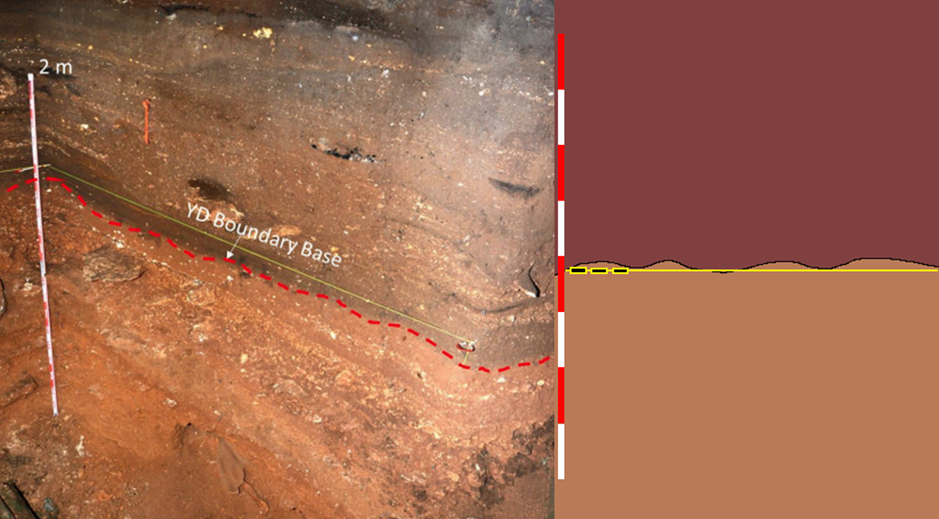
Figure 3. Hall’s Cave stratigraphy. Left: actual photo from Sun et al. 2020 showing stratigraphy from Hall’s Cave. Red Dotted Line = Purported YD boundary layer. Right: Simple diagram demonstrating the issues introduced by distinct sampling events in different areas of the cave. Yellow Line = Height based on datum (Red & White Pole). Black Box = Hypothetical sample area. Adapted from Sun et al. 2020.
All heights/depths in Hall’s Cave are obtained using a centralised datum established in 1986 (Sun et al. 2020), shown by the measuring tape in the left panel. Because the stratigraphy undulates up and down (Figure 3), samples taken from the same datum depth but different horizontal locations are, in fact, capturing different soil horizons. For their sampling episodes to be comparable, they would essentially need to use stratigraphic boundaries (the transition between distinct layers) as their datum in the same way that volcanic tephra layers are used as chronological anchors in other studies. This has been the method often used by YDIH proponents since day one.
The right-hand panel of Figure 3 demonstrates this issue clearly. Each black rectangle represents a different sample year, all taken at the same depth according to the site-wide datum (yellow horizontal line). In this example, the true YDB (black wavy line) is only just barely captured in the corner of one sample during one sampling episode. This may be why one of the 2017 samples from 151 cm contains a much higher concentration of Pt than the others at the same depth (435.1 ppt); perhaps that sample managed to just barely scratch the true YDB, while the others missed it entirely.
This error is catastrophic to their interpretations; their data can only be considered reliable when all three sampling episodes are plotted separately and/or at least anchored by stratigraphy. This error also means that their five claimed volcanic signatures throughout the section are more than likely representative of three events, as three are the most that appear in the same sampling episode; at least two of their proposed events were likely duplicated between sampling episodes. Most interestingly, none of the volcanic events occur close to the YDB in the sampling episode with three volcanic events.
As if this catastrophic error was not bad enough, there is another, much worse issue concerning data integrity within this paper. Close examination of the ‘depth’ column in yellow (Figure 2) reveals a consistent sample resolution of 1-2 cm throughout most of the section, except for one glaring anomaly. After 151 cm depth, there is an abrupt leap to 155 cm, highlighted in blue (Figure 2), that results in a gap of 4 cm. A sample from 153 cm would slot beautifully into this gap to complete the section, and its absence is conspicuous.
Because the conclusions of this paper are based on correctly interpreting the 151 cm sample, which sits directly above the missing 153 cm sample, its inclusion is very important. Perhaps we can learn something about the missing 153 cm sample from other investigations. Luckily, the YDB at Hall’s Cave was examined for impact proxies by the YDB team back in 2009 (Figure 4), so what did they find?
The study, led by Dr. Thomas Stafford Jr. (2009), in collaboration with the early YDB team (and whistle-blower against this study), found a discrete peak of nanodiamonds, magnetic microspherules, carbon spherules, and biomass-burning proxies in the YDB layer at between 151 and 153 cm (Figure 4). So, here we have precedent that the layer containing these proxies at Hall’s Cave occurred between 151 and 153 cm. The presence of multiple impact proxies between 151 and 153 cm demonstrates that the YDB at Hall’s Cave can be found at that depth; of course, this was only the case for the specific samples taken for the 2009 study, and as explained earlier, 153 cm depth is not the only possible location for the YDB, as the soil profile undulates.

Figure 4. Truncated abstract from a poster presentation at the American Geophysical Union Fall Meeting 2009 by Dr. Thomas Stafford Jr., the principal investigator of Hall’s Cave, in collaboration with the YDB team. Red Box = highlighting the depth of the YDB. Red Underline = Important information about the YDB at Hall’s Cave. Yellow Box = Samples from the same depth in Sun et al. (2020), with the missing 153 cm sample highlighted by the red line.
Despite their brief discussion of the global Pt anomaly, demonstrating their awareness of its existence and its claimed geochronological utility for locating the YDB, the authors do not use the small Pt spike at 151 cm as evidence in support of their interpretation of the YDB layer. Doing so would only have supported their case, as the Pt has been repeatedly replicated at the YDB, and using it as supporting evidence does not mean admitting it came from an impact event. Because Sun et al. (2020) is ultimately devoted to testing the YDIH, it is unconscionable that the 153 cm sample was not included. So why is this important sample missing from the dataset? Well, perhaps if they found a large Pt spike in their 153 cm sample, including it in their dataset would have complicated their interpretation of the 151 cm sample representing the YDB for the reason stated above. This would render their conclusions entirely unsupportable.
Another author, who was originally on this paper, reached out to YDB proponents, sharing his concerns with their paper. They provided additional information and context behind the paper, as well as a document cache. Documents in the cache included copies of the original data at every stage of the manuscript, including from before the sample from 153 cm was omitted from the dataset. In addition, they provided substantial documentation, including all stages of drafts, comments and communications between themselves and the authors, and a copy of the formal request to Science Advances to have their name removed from the paper; the other authors rushed to submit it after ignoring the issues detailed previously, which may also be a potential violation of the journal’s publishing policies. The available drafts from before and after the 153 cm sample was omitted allow investigators to determine precisely where the authors went rogue.
In a major twist that nobody could have seen coming, the omitted sample from 153 cm contained by far the highest concentration of Pt in the entire record (1807 ppb), more than 4x the elevated Pt in the single 151 cm sample mentioned earlier (Figure 5).
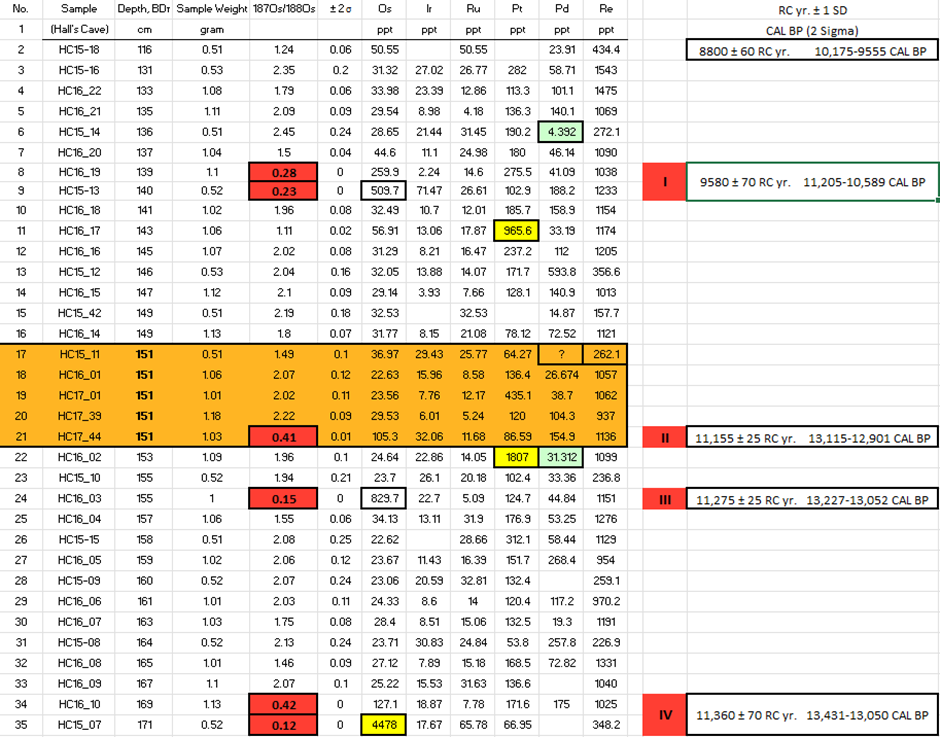
Figure 5. Dataset prior to the omission of the 153 cm sample containing a significant Pt spike that the authors have acknowledged as occurring at the YD onset and supporting the YDIH.
Attempts to contact the corresponding authors to ask them about the issues with the paper were met with resistance, insults, and redirects (Figure 6). In this reply, the “corresponding author” belittled Dr. Martin Sweatman’s work on the YDIH and mischaracterised their former coauthor’s dissatisfaction with the paper as being due to it not supporting the YDIH. Nothing could be further from the truth, as Stafford has reiterated multiple times to me that he has significant criticisms of the YDIH. A follow-up email declaring our intent to raise the issue with the journal and the author’s institutions was met with indifference and hostility; one of them CC’d my academic supervisor in their response, no doubt seeking to elicit personal consequences for having the audacity to reach out to them seeking an explanation prior to going public with these issues.

Figure 6. Email response to my inquiry regarding the issues with sampling methodology and missing data from the “corresponding author” listed on Sun et al. (2020).
Given the recent escalation in politically motivated retractions (Tankersley et al. 2022; Natawidjaja et al. 2024), and the years-long harassment campaign on PubPeer and other social media platforms by critics like Mark Boslough and his anonymous army of trolls against dozens of papers supporting the YDIH, it only seems fair that major issues with papers purporting to discredit the YDIH are treated with the same level of scrutiny.
Unfortunately, the fatal issues with Sun et al. (2020) mean it does not pass muster, and the only responsible course of action includes a formal inquiry into the circumstances surrounding the omission of crucial data, followed by a full retraction of Sun et al. (2020). Even assuming no intent behind the omission of the data, the other issues outlined in this report are grounds for retraction. Therefore, a formal request for retraction will soon be launched with the journal (Science Advances), and the document package containing the omitted data and contextual evidence will be made available to any investigators who request them.
References:
Abbott, P.M., U. Niemeier, C. Timmreck, F. Riede, J.R. McConnell, M. Severi, H. Fischer, A. Svensson, M. Toohey, F. Reinig & M. Sigl 2021 Volcanic climate forcing preceding the inception of the Younger Dryas: Implications for tracing the Laacher See eruption. Quaternary Science Reviews 274:107260.
Anders, E. 1975 Do stony meteorites come from comets? Icarus 24(3):363-371.
Beets, C., M. Sharma, K. Kasse & S. Bohncke 2008 Search for extraterrestrial osmium at the Allerod – Younger Dryas boundary. American Geophysical Union, Fall Meeting V53A-2150.
Campins, H. & T.D. Swindle 1998 Expected characteristics of cometary meteorites. Meteoritics & Planetary Science 33(6):1201-1211.
Engels, S., C.S. Lane, A. Haliuc, W.Z. Hoek, F. Muschitiello, I. Baneschi, A. Bouwman, C.B. Ramsey, J. Collins, R. de Bruijn, O. Heiri, K. Hubay, G. Jones, A., Laug, J. Merkt, M. Muller, T. Peters, F. Peterse, R.A. Staff, A.T.M. ter Schure, F. Turner, V. van den Bos & F. Wagner-Cremer 2022 Synchronous vegetation response to the last glacial-interglacial transition in northwest Europe. Communications Earth & Environment 3:130.
Horan, M.F., R.J. Walker, J.W. Morgan, J.N. Grossman & A.E. Rubin 2003 Highly siderophile elements in chondrites. Chemical Geology 194(1-4):27-42.
Natawidjaja, D.H., A. Bachtiar, B.E.B. Nurhandoko, A. Akbar, P. Purajatnika, M.R. Daryono, D.D. Wardhana, A.S. Subandriyo, A. Krisyunianto, Tagyuddin, B. Ontowiryo & Y. Maulana 2023 RETRACTED: Geo-archaeological prospecting of Gunung Padang buried prehistoric pyramid in West Java, Indonesia. Archaeological Prospection 2023:1-25.
Paquay, F.S., S. Goderis, G. Ravizza, F. Vanhaeck, M. Boyd, T.A. Surovell, V.T. Holliday, C.V. Haynes Jr. & P. Claeys 2009 Absence of geochemical evidence for an impact event at the Bølling-Allerød/Younger Dryas transition. Proceedings of the National Academy of Sciences 106(51):21505–21510.
Petaev, M.I., S. Huang, S.B. Jacobsen & A. Zindler 2013 Large Pt anomaly in the Greenland ice core points to a cataclysm at the onset of Younger Dryas. Proceedings of the National Academy of Sciences 110(32):12917–12920.
Riches, A.J.V., J.M.D. Day, R.J. Walker, A. Simonetti, Y. Liu, C.R. Neal & L.A. Taylor 2012 Rhenium-osmium isotope and highly-siderophile element abundance systematics of angrite meteorites. Earth and Planetary Science Letters 353-354:208-218.
Sharma, M., C. Chen, B.P. Jackson & W. Abouchami 2009 High resolution osmium isotopes in deep-sea ferromanganese crusts reveal a large meteorite impact in the Central Pacific at 12 ± 4 ka. American Geophysical Union, Fall Meeting PP33B-06.
Stafford Jr., T.W., E. Lundelius, J.P. Kennett, D.J. Kennett, A. West & W.S. Wolbach 2009 Testing the Younger Dryas ET impact (YDB) evidence at Hall’s Cave, Texas. American Geophysical Union, Fall Meeting PP33B-08.
Sun, N., A.D. Brandon, S.L. Forman, M.R. Waters & K.S. Befus 2020 Volcanic origin for Younger Dryas geochemical anomalies ca. 12,900 B.P. Science Advances 6:EAAX8587.
Svensson, A., D. Dahl-Jensen, J.P. Steffensen, T. Blunier, S.O. Rasmussen, B.M. Vinther, P. Vallelonga, E. Capron, V. Gkinis, E. Cook, H.A. Kjaer, R. Muscheler, S. Kipfstuhl, F. Wilhelms, T.F. Stocker, H. Fischer, F. Adolphi, T. Erheardt, M. Sigl, A. Landais, F. Parrenin, C. Buizert, J.R. McConnell, M. Severi, R. Mulvaney & M. Bigler 2020 Bipolar synchronization of abrupt climate change in Greenland and Antarctic ice cores during the last glacial period. Climate of the Past 16:1565–1580.
Sweatman, M.B. 2021a The Younger Dryas impact hypothesis: Review of the impact evidence. Earth–Science Reviews 218:103677.
Sweatman, M.B. 2021b Response to a comment by Jorgeson, Breslawski and Fisher on “The Younger Dryas impact hypothesis: Review of the impact evidence” by Sweatman. Earth Science Reviews 225:103897.
Tagle, R. & P. Claeys 2005 An ordinary chondrite impactor for the Popigai crater, Siberia. Geochimica et Cosmochimica Acta 69(11):2877-2889.
Tankersley, K.B., S.D. Meyers, S.A. Meyers, J.A. Jordan, L. Herzner, D.L. Lentz & D. Zedaker 2022 Retracted Article: The Hopewell airburst event, 1699-1567 years ago (252-383 CE). Scientific Reports 12:1706.
van Hoesel, A., W.Z. Hoek, G.M. Pennock & M.R. Drury 2014 The Younger Dryas impact hypothesis: A critical review. Quaternary Science Reviews 83:95-114.






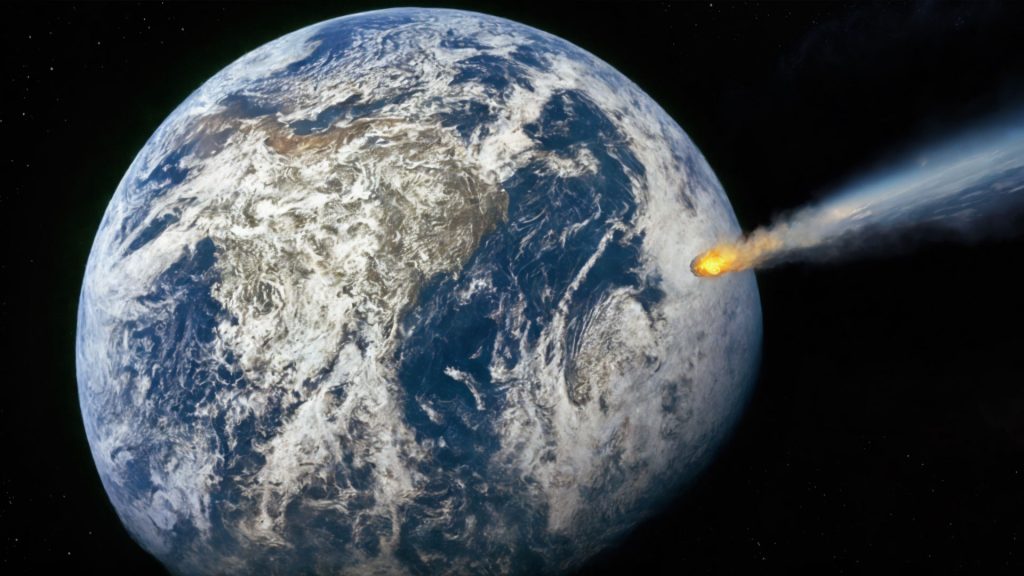
Thank you to Graham for having the integrity to platform this important revelation.
The moderators of PubPeer refused to publish it until all references to the data integrity issue were removed.
Science Advances refused to publish it as an eLetter (post-publication peer review) on the original paper.
Retraction Watch, supposedly a bastion of scientific integrity, ignored my emails.
The truth will not be defeated.
If any party wants to play dirty, I will release all the receipts.
Saptrishi , great floods, polaris swastika, younger dryas, iceage all related and driven by stars linked to polaris
https://youtu.be/YtoLmKJit4g
egyptian and yug all related to time pace kundalini evolution
Please find the secret on evolution and kundalini and the secret behind 432,000 assumed years of kalyug . 4320 is secret code
https://www.youtube.com/watch?v=38tLvPWWdwk